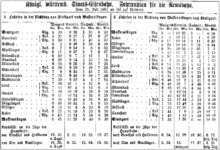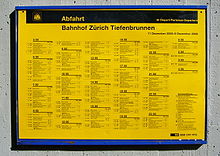Timetable



A timetable (abbreviation: Fpl ) defines the route of a means of transport in local and long-distance public transport and in rail freight transport . The necessary information is train number , days of operation , route, arrival, departure and transit times at the operating points as well as the permissible speeds in the individual sections of the route. It is created in the timetable and provides the basis for the vehicle schedule .
Furthermore, the term is also used for a plan of the arrival and departure times of a means of transport at the respective stops or the corresponding media for displaying this plan.
The first timetable coach service was established in Great Britain in 1784. In 1840 there was the first train timetable there.
Schedule period and schedule year
A timetable is usually valid for a certain period of time, the timetable period . When speaking of the current timetable period, what is meant is a currently valid timetable.
Until 2001, the European railways changed their timetables once a year, on a Sunday at the end of May or the beginning of June. In Germany , the timetable period was divided into a summer and winter section and published in separate course books until the early 1990s . So there were two timetable sections per year, which were also referred to as summer and winter timetables , whereby in all Central European countries the summer timetable only comprised four months and the winter timetable the other eight. The annual timetable was reintroduced in Switzerland as early as 1987 - as it was before 1909.
For the states of the European Union, the Commission stipulated that with the 2003 timetable year, the annual timetable change must take place on the second Saturday in December at midnight, and the minor timetable change during the year on the second Saturday in June at midnight. Previously, the last Saturday in May at midnight was the time of the annual timetable change and the last Saturday in September at midnight was the timetable change during the year. Thus, on December 15, 2002, Europe switched from a summer and winter timetable to an annual timetable. The duration of a timetable year varies between 52 weeks (= 364 days) and 53 weeks (= 371 days). The European Passenger Train Timetable Conference (FTE) is responsible for coordinating the timetables .
For practical reasons, Switzerland is taking over the regulation of the timetable change from the European Union. The timetable period usually lasts two timetable years. This means that only minor changes to the timetables should be made in December of the even years.
Apart from the European rail network, other times are also to be found for the timetable change. B. on a Saturday in March.
Timed timetable
The interval timetable , which is widely used today, is of particular importance in regular services . It is easy to remember because the departure and arrival times are repeated at periodic intervals. The integral cycle timetable , which is being used in more and more European countries, also has a uniform symmetry time for all routes , which means that transfer times are always the same for outward and return journeys .
Departure time
In western countries, departure time means the point in time or the precisely determinable time at which a means of transport leaves a stop or a comparable point of departure. The term trip refers here to rolling means of transport or ships.
depiction
The timetable is published in the form of a course book , timetable book / timetable booklet , a notice timetable or in electronic media. It can also be displayed graphically in the form of a time-path diagram ( picture timetable ) or a network graphic .
In the past, the timetable at German and Austrian train stations was often drawn up on rolls. These role schedules are today z. B. can still be seen in the Czech Republic.
For internal service purposes, the timetables are published as book timetables , travel time booklets , speed booklets , timetables for train registration offices (formerly: station driving regulations) and electronically with EBuLa .
Small and temporary deviations from the current timetable are displayed by various railway companies in the traveler information system ( RIS ). Various operating companies also offer timetable information on the Internet with an overview of the scheduled implementation of the trips on their lines.
Course books
A collection of several timetables is often called a course book , especially in the railway sector , otherwise a timetable book or timetable booklet.
Notice timetable

At train stations or stops for public transport, there are posted timetables (also known as timetable posted) in very different forms for providing passenger information . Excerpts from the timetable are published in it. The departure and arrival platforms / bus platforms of the trains or buses are often shown at important intersection points . The final destination and the departure time of a transport offer are given in chronological order , usually also the route of the route .
If the arrival time is approximately the same as the departure time due to the short stopping time, a notice marked as “timetable” is sufficient, otherwise separate notices are offered for arriving (“arrival”, white) and departing (“departure”, for railways mostly on yellow paper) means of transport . The arrival plan for railways contains all offers arriving at a stop and a selection of the stops that the respective train has reached (usually with the departure time there). The arrival platform is also given. The departure times on a posted timetable are usually sorted according to the day of the week (Monday – Friday, Saturday , Sunday and public holidays ) for better clarity .
A distinction must be made between notices for all journeys from a stopping point and route-related information. The latter can be created individually for each line or refer to specific directions or destinations. A subdivision into long-distance and regional transport and inner-city offers is also possible. In some areas, for example, there are special timetables for S-Bahn traffic, or city bus timetables can be separated from regional lines (even continuous lines can then be divided into inner-city and regional parts).
Depending on the concept, a representation with full details of the route (and all departure times of stops on the way) for each individual offer or a general route information with the following listing of the individual journey times can be made. Line-related information, especially in the case of clocked offers, is usually given in a flat-rate form due to greater clarity. In rail traffic, an individual representation is predominantly used for each train offer.
Symbols and / or footnotes provide additional information
- deviating route routes or stop operations
- the name of the station up to which all intermediate stops are named
- Traffic restrictions on certain days (for example during school holidays)
- restricted transport options or a reservation requirement for bicycles etc.
The clarity can suffer due to the use of too many symbols for individual journeys. Special offers such as dial-a-bus or shared tax service (special types of public transport ) are also often identified by symbols. However, additional notices with complete information about the offer, operating modalities and any special tariff features are also possible.
Often the notice timetable also contains a tabular list of all stops served with travel times and connection information.
At large train stations, timetable excerpts are now displayed dynamically and with the latest additional information on departure boards. Each individual trip within a certain period of time is listed as comprehensively as possible with an indicated route.
Internet timetable
Various transport companies provide a mobile app on which up-to-date timetables can be called up. Current delays, operational disruptions or changes to the platform as well as current fares are often shown online. These timetable APPs can also be used to buy tickets online.
Other meanings
In addition to the timetable, which is published as passenger information, there is a book timetable and a picture timetable for describing internal company processes .
In project planning, one also speaks of timetables or roadmaps , in which the time windows for activities and milestones are specified. A well-known example is the roadmap (Middle East conflict) .
Legal basis
The timetable is defined in Section 40 of the German Passenger Transport Act . The components are the routing of the line, the starting point, the end point and the travel times. It must be approved by the traffic authority.
Time display
If the timetable changes only with regard to the arrival and departure times at the stops, the change can be requested from the licensing authority as a time display . This reduces the fees and the process can be processed more quickly, as no hearing of the responsible party is necessary.
See also
Web links
- Deutsche Bahn travel connections
- Timetable of the Swiss Federal Railways
- Online timetable information from the Austrian Federal Railways (ÖBB)
- Arrlee - proximity search for public transport in D / A / CH
Individual evidence
- ↑ So z. B. in the driving service regulation Ril 408
- ↑ Jörn Pachl: System technology of rail traffic: plan, control and secure rail operations , Teubner-Verlag 2004, ISBN 3-519-36383-6 , p. 189.
- ↑ Yuval Noah Harari : A Brief History of Humanity . Pantheon-Verlag 2015, kindle edition, p. 430.
- ↑ This is how a timetable change works on Inside.bahn.de, October 12, 2020
- ↑ EU Commission: 2002/844 / EG: Commission decision of October 23, 2002 amending Directive 2000/14 / EG (sic!) With regard to the date for changing the network timetable in rail transport (text of relevance for the EEA) (Notified under document number K (2002) 3997); What is meant is an amendment to Directive 2001/14 / EC , accessed on March 20, 2014
- ↑ European Parliament / European Council: Directive 2001/14 / EC of the European Parliament and of the Council of February 26, 2001 on the allocation of rail infrastructure capacity, the levying of charges for the use of railway infrastructure and safety certification , accessed on March 20 2014
- ↑ see explanations for the official timetable publication in Switzerland , accessed on March 21, 2014
- ↑ Timetable Ordinance on the website of the federal authorities of the Swiss Confederation , accessed on March 21, 2014
- ↑ Full text § 40 PBefG - accessed on May 13, 2019
- ↑ Holger Zuck, Klaus-Albrecht Sellmann, Passenger Transport Law , 4th edition 2013
- ^ Karl-Heinz Fielitz, Thomas Grätz, Comment on Passenger Transport Act , 2018




